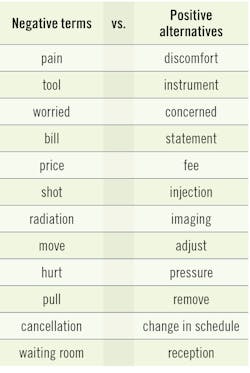Promoting positivity: How word choice can improve patient experience
When I begin my workday as a dental professional, I tell myself: Today is going to be a great day, and I will share that sentiment with every patient I see. I use my demeanor, enthusiasm, and words to share my sense of positivity because, ultimately, I want my patients to feel as good as I do, especially when they are in my operatory, under my care. Patients may enter my room feeling fearful or nervous, but I know I have the power to change that. We all do.
The way we speak to patients has a profound effect on their dental experience, both physically and emotionally. Our tone of voice, volume, talking speed, facial expressions, and attitude all contribute to the messages we send and how they are received. If we talk too fast, a patient can feel rushed or anxious, but if we talk softly, we can promote calm. Likewise, if we choose negative terms, a patient could feel threatened. It is of the utmost importance that we be purposeful with our messaging because we can inadvertently undermine our own intentions through careless or subconscious choices. To ensure that our communication with patients is associated with a positive experience, we must choose our words carefully.
To do this, we first need to understand what it means to be either positive or negative. To put into words what we all generally understand from our own lives, Merriam-Webster defines being positive as “having a good effect” or being “marked by optimism.”1 On the other hand, to be negative means being “marked by features of hostility, withdrawal, or pessimism that hinder or oppose constructive development.”2
Second, we should acknowledge that feelings shape experiences. Feelings associated with positivity are happiness, confidence, joy,Through research, we can see how these concepts in communication work. Famed neurologist Andrew Newberg and leader in neuroscience communication Mark Robert Waldman have spent their careers studying and teaching the effects of positive and negative word choices. In their best-selling book, Words Can Change Your Brain, they warn against the dangers of negativity. They state, “negative words send alarm messages through the brain, interfering with the decision-making centers in the frontal lobe, and this increases a person’s propensity to act irrationally,” while “positive words and thoughts propel the motivational centers of the brain into action and help us build resilience when we are faced with problems.”3
Armed with this knowledge, we understand that focusing on our words and phrases will in fact help us achieve our goal of a feel-good, positive patient experience. To take it one step further, Ernil Hansen and Nina Zech affirm the importance of mindful language choices in the clinical setting. In a recent Frontiers in Pharmacology article, they write, “Health-care personnel should be aware of and evaluate what patients are exposed to, hear, and see. Knowing more about the effects of nocebos and negative suggestions, combined with increased attention to these matters, provides the basis for better recognition of detrimental influences in their own clinical environment and to be able to avoid, stop or neutralize them.”4
Simply stated, they suggest that the fewer negative stimuli in the medical space, via words and nonverbal elements, the better the patient experience. As dental hygienists, this awareness illustrates how choosing our words wisely will help us minimize or avoid negative experiences. For example, consider the difference between, “This is going to hurt. Please stay still, it will be over soon,” and “I am sorry this may be a bit uncomfortable; you’re doing great. We’re almost finished.” Both statements contain the same information, but the first emphasizes pain and lack of personal control—in short, it feels scary and negative. The latter is encouraging and supportive, conveying a sense of safety and positivity. Very different messages, very different feelings, and a very different dental experience.
In effort to make every patient experience a positive one, even during rigorous or stressful treatments, let us consider our arsenal of words and identify which ones will help us achieve our goal. Table 1 gives some great examples of fear-provoking, negative terms versus less-loaded, positive alternatives.
These seemingly minor adjustments in word selection result in major improvement in the tone of our communication. We’re able to get the same information across, but in a manner that promotes positivity and comfort: two elements essential for successful patient care. Selfishly, I like saying positive things and hearing positive things in return. I want to feel good and know that my method of communication can help my patients feel good. Perhaps I can help them think positively about a treatment they dread or help them focus on the attentive care they are receiving rather than dwell on possible pain or difficulty. Fortunately, we can all do this with a bit of mindfulness. As clinicians, educators, and friends, let us keep our communication positive with the right words, seizing the opportunity to send a better message.
REFERENCES
- Positive. Merriam-Webster. Accessed October 19, 2020. https://www.merriam-webster.com/dictionary/positive
- Negative. Merriam-Webster. Accessed October 19, 2020. https://www.merriam-webster.com/dictionary/negative
- Newberg A, Waldman M. Why this word is so dangerous to say or hear. Psychology Today. August 1, 2012. Accessed October 19, 2020. https://www.psychologytoday.com/us/blog/words-can-change-your-brain/201208/why-word-is-so-dangerous-say-or-hear
- Hansen E, Zech N. Nocebo effects and negative suggestions in daily clinical practice - Forms, impact and approaches to avoid them. Front Pharmacol. 2019;10:77 doi:10.3389/fphar.2019.00077
About the Author
Tanya Gold, BS, BA, RDH
TANYA GOLD, BS, BA, RDH, specializes in public relations, practice enhancement, and communication strategies. She is the founder and director of Gold’s Dental Charm School, which focuses on training in social graces for the dental professional. Prior to dentistry, Ms. Gold worked for over a decade in customer service, public relations, and marketing. She earned a bachelor of science in dental hygiene from the University of Southern California and a bachelor of arts in communication from California State University, Northridge.
Updated January 8, 2020


